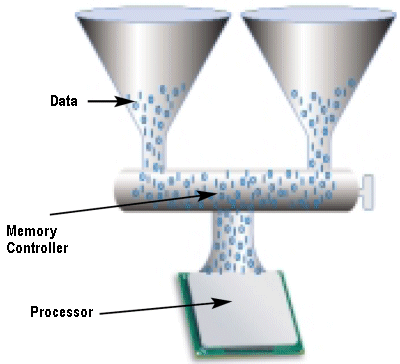The terminology dual-channel DDR is, in fact, a misnomer. The fact is there’s no such thing as dual-channel DDR memory. What there are, however, are dual-channel platforms.
When properly used, the term dual channel refers to a DDR motherboards chipset that’s designed with two memory channels instead of one. The two channels handle memory-processing more efficiently by utilising the theoretical bandwidth of the two modules, thus reducing system latencies, the timing delays that inherently occur with one memory module. For example, one controller reads and writes data while the second controller prepares for the next access, hence, eliminating the reset and setup delays that occur before one memory module can begin the read/write process all over again.
Consider an analogy in which data is filled into a funnel (memory), which then channels the data to the CPU.
Single-channel memory would feed the data to the processor via a single funnel at a maximum rate of 64 bits at a time. Dual-channel memory, on the other hand, utilises two funnels, thereby having the capability to deliver data twice as fast, at up to 128 bits at a time. The process works the same way when data is emptied from the processor by reversing the flow of data. A memory controller chip is responsible for handling all data transfers involving the memory modules and the processor. This controls the flow of data through the funnels, preventing them from being over-filled with data.

It is estimated that a dual-channel memory architecture is capable of increasing bandwidth by as much as 10%.
The majority of systems supporting dual-channel memory can be configured in either single-channel or dual-channel memory mode. The fact that a motherboard supports dual-channel DDR memory, does not guarantee that installed DIMMs will be utilised in dual-channel mode. It is not sufficient to just plug multiple memory modules into their sockets to get dual-channel memory operation – users need to follow specific rules when adding memory modules to ensure that they get dual-channel memory performance. Intel specifies that motherboards should default to single-channel mode in the event of any of these being violated:
- DIMMs must be installed in pairs
- Both DIMMs must use the same density memory chips
- Both DIMMs must use the same DRAM bus width
- Both DIMMs must be either single-sided or dual-sided.
DDR SDRAM DIMMs have 184 pins (as opposed to 168 pins on SDRAM, or, 240 pins on DDR2 SDRAM), and can be differentiated from SDRAM DIMMs by the number of notches (DDR SDRAM has one, SDRAM has two).
- What is Level 1 (L1) Cache Memory?
- What is L2 (Level 2) cache memory?
- RAM or Main Memory – PC / computer memory (DIMM, DRAM, SDRAM)
- DRAM – Dynamic Random Access Memory
- FPM DRAM
- EDO (Extended Data Out) and BEDO (Burst Extended Data Out) DRAM
- SDRAM
- PC133 SDRAM
- DDR SDRAM explained
- DDR2 DRAM
- Dual Channel DDR Memory
- 1T SRAM
- Direct DRAM
- SIMMs
- DIMM Memory
- RIMMs Memory
- Memory Presence Detection
- Parity Memory
- ECC Memory
- Memory Upgrades
- The Evolution of Memory
- Flash Memory
- Magnetic RAM
thnk U…